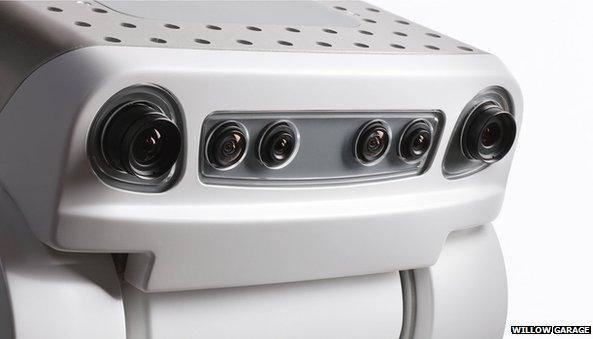Could remote crowdworking change how we care for our elderly?
- Published

Willow Garage's Heaphy Project allowed remote users to control this robot and carry out tasks using just a web browser
Many of us have strong views on outsourcing.
Whether it's the uncomfortable image of a low-paid army of workers shuffling onto almost impossibly long production lines in Asia, or the offshore call centre worker struggling through a conversation offering technical support, the feeling of farming off work that could be done by local workers is one which fills some with unease.
Yet as connectivity and technology mean the barriers to outsourcing are beginning to almost disappear entirely, outsourcing is graduating into another trend that is changing how we treat repetitive human work.
Crowdworking is growing, fast. Ville Miettinen, chief executive of "human powered document processing" service Microtask, says business at his crowdworking company is increasing at around 400% year-on-year - and his experience is typical of the wider industry.
It beckons a new way of approaching huge, often dull, tasks. Where once a company would hire a bunch of temporary workers, or eager teens happy with minimum wage, it can now call on workers from all over the world to collaborate on huge tasks while simply sitting at their computer.
Heaphy Project
To date, outsourcing has largely been an exercise in getting some of our less glamorous industries out of sight and mind. However, the practice could now be about to come full circle.
Willow Garage is a robotics company based in California. It pioneers the use of human-in-the-loop systems - that is, actions which robots can't quite manage on their own, but with a simple piece of human intervention can finish the job.

In a proof of concept demo, a remote worker controls a robot in order to pick up an elderly patient's water bottle
By using Mechanical Turk, Amazon's crowdworking platform which allows workers all over the world to remotely carry out small tasks for small cash rewards, they have made the first steps in what they eventually believe could be a way to outsource even the most delicate of tasks, such as caring for the elderly.
Its Heaphy Project is a system which allows a person to control a robot remotely using just a web browser.
Users, who watch what's happening via a video feed, can move the robot around and control its arms to such a precise degree it can pick up objects.
Willow Garage believe this method could be used to allow remote workers carry out tasks such as production line work, or even, for example, aiding an elderly or disabled person reach an object which they have dropped.
Dirty dishes
Initially, to test the scheme, interested users on Mechanical Turk had to learn how to pick up dirty dishes from the desks of Willow Garage employees before carrying them to a kitchen sink.
"People would sign-up through Mechanical Turk, and then they would be taken to a training room, if you will, and they had to complete a series of tasks," explains Bob Bauer, Willow Garage's director of commercialisation.
"The first set of tasks were done all in simulation before they were allowed on the robot - like a pilot in a simulator.
"Then in a very constrained environment they did the task with a real robot, with real cups on real tables, learning how to pick them up. Those that showed a certain amount of capability were then allow to do the next step of do the task in the real world."
They trained hundreds of people using this method, in thousands of training sessions.
Mr Bauer believes that as the demand for elderly care increases in years to come, such human-in-the-loop robotic care will become common place.
"We're in conversation with everything from elderly care facilities to people who are doing security applications in order to understand what's the right mix of being automated and human intelligence being brought to the problem."
The robots can also be used for other less-than-desirable tasks, as demonstrated by one research programme at Willow entitled Perception Of Offensive Products and Sensorized Control Of Object Pickup - or POOP SCOOP, for short.
Military records
Despite huge leaps in technology, remote control robot carers are still some way off.
Today, crowdworking is a little more low-key, but no less disruptive to long-established work practices.
Microtask's Mr Miettinen offers a massive workforce available at a company's beck and call without the hassle - to put it insensitively - of hiring and firing employees to meet business needs.

Ville Miettinen, chief executive of Microtask, says over 120,000 have worked through his site
Microtask takes a set of documents - say, membership forms - and splits them into small pieces to be processed by workers.
"The individual tasks are really small," Mr Miettinen explains. "It can be just a single word out of a document. They're not seeing the entire page, they don't know what the rest of the page contains, and they also don't know who else is working on it."
It means several people, in several continents, can all collaborate to process one individual form.
"We can outsource to pretty much anywhere on the planet," he says.
"We're doing a lot of distributed outsourcing to places like Pakistan, rural India, the Philippines, China and other countries."
In the US, such methods have been used to process military and even medical records - but the export of such data is covered by strict privacy laws.
Microtask pays works at the typical local rate, although in the US it will, in some cases, fall below the minimum wage for hourly work.
Nevertheless, it hasn't stopped over 120,000 people signing up to work on the platform since its inception in 2009.
As the industry goes, more and more companies will start to shun local workers in favour of their cheaper crowdworked alternatives. It is, as Mr Miettinen describes, the "human equivalent of cloud computing".